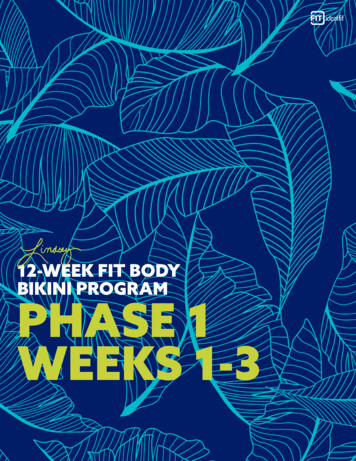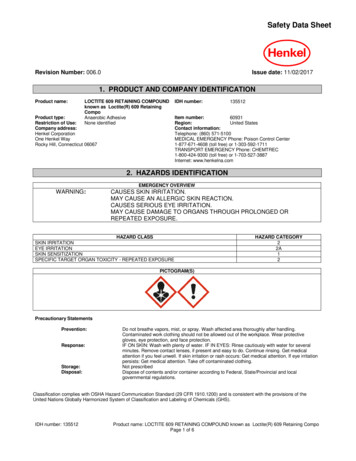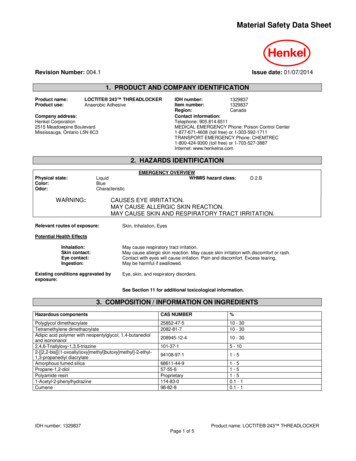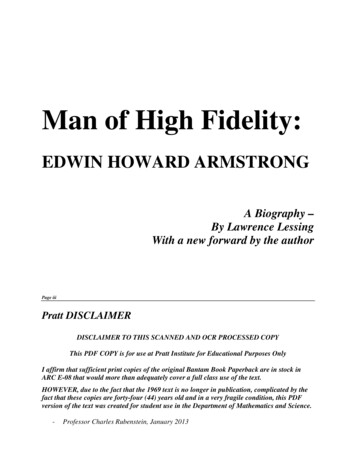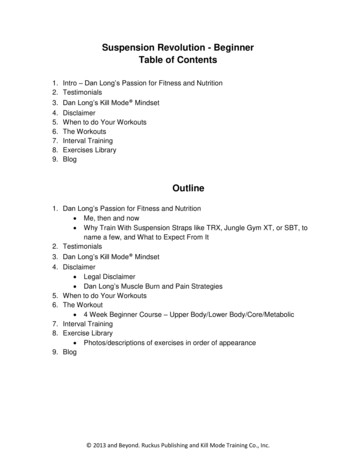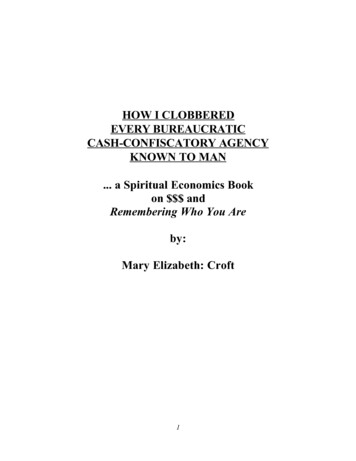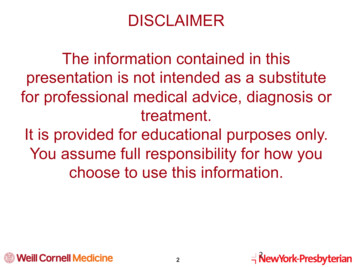
Transcription
DISCLAIMERThe information contained in thispresentation is not intended as a substitutefor professional medical advice, diagnosis ortreatment.It is provided for educational purposes only.You assume full responsibility for how youchoose to use this information.22
Integrative Health:Comprehensive Care for Your Mind and BodyAlka Gupta, M.D.Jackie Topol, MS, RD, CSO, CDNOleg Fabrikant, DAOM, LAcOctober 3, 2017
What is Integrative Health?Bringing together conventional andcomplementary approaches in acoordinated wayNational Center for Complementary and Integrative Health 1
Integrative Health as a Growing TrendThere is a rising interest amongst Americans to incorporate IntegrativeMedicine (IM) practices into their healthcare regimen.According to the National Center for Complementary and Integrative Health(NCCIH) at the National Institute of Health (NIH), nearly40%of Americans use IM.2
Increased Government FundingThe National Center forComplementary and IntegrativeHealth (NCCIH) is the FederalGovernment's lead agency forscientific research oncomplementary and integrativehealth approaches.3
Academic Institutions Advancing Integrative HealthMembers (sampling): Mayo ClinicJohns Hopkins UniversityWeill Cornell MedicineColumbia UniversityCleveland ClinicDuke UniversityHarvard Medical SchoolMD AndersonMount Sinai Medical CenterNorthwestern UniversityStanford UniversityUCSF
U.S. Healthcare Expenditures
Leading Causes of Death in the U.S.
Current Interventions Are Not Sufficient
What is the Objective of Integrative Health and Wellbeing?Individualized healthcare combining conventional and evidencebased integrative medical treatments to promote physical,psychological, and spiritual well-beingNutritionYogaHealth CoachingPsychologyMeditationRelaxation & BreathingTechniquesAcupunctureMassage TherapyPilates5
What Should I be Eating?
What is inflammation? Inflammation is the mechanism in which the body protects itself from injury,irritation, or infection. Not all inflammation is bad– Acute inflammation is a response to tissue damage and lasts only ahandful of a days. It isolates damaged areas and promotes healing.– Chronic systemic inflammation affects your entire body and negativelyimpacts health.
Can we put out the fire with diet?
What does the research say? Studies have shown that diets high in refined starches, sugars, saturated fats, andtrans fats and low in fruits, vegetables, whole grains, and omega-3 fatty acidsappear to turn on the inflammatory response. A study that looked at fruit and vegetable intake among adults found that thosewho had the highest consumption ( 2 servings of fruit and 3 servings ofvegetables per day) had significantly lower levels of inflammatory markers in theblood as well as decreased biomarkers of oxidative stress.Giugliano D, Ceriello A, Esposito K. The effects of diet on inflammation: emphasis on the metabolic syndrome. 2006.Root M, McGinn M, Nieman D, et al. Combined Fruit and Vegetable Intake Is Correlated with Improved Inflammatory and Oxidant Status from a Cross-Sectional Study ina Community Setting. 2012.
Mediterranean Diet
The New American Plate from AICR
Healthy Eating Plate from theHarvard School of Public Health
What do all these diets have in common? Focus on a variety of vegetables and fruits Have smaller amounts of protein and choose leansources Choosegrains instead ofcarbohydrates Use healthy fats Add beans, nuts, and seeds Cook with herbs & spicesBottom line: Minimally, if at all, processed foods
“SAD Diet” Fried food Processed meats Trans fat Excess omega-6 fats Refined flour Sugar Lack of fiber DiabetesHigh cholesterolHigh blood pressureStrokeCancerKidney diseaseOsteoporosisAlzheimer’sObesityIrritable Bowel Syndrome
“SAD Diet” versus “Health-Supportive Diet”for our gut
What is Irritable Bowel Syndrome (IBS)?Recurrent abdominal pain or discomfortat least3 days/month in the last 3 monthsassociated with2 or more of the following:Improvement withdefecationOnset associatedwitha change in formof stoolOnset associatedwitha change infrequencyof stoolAnd no “red flags”: weight loss, rectal bleeding, family history of cancer/IBD, unexplained abnormalities in bloodwork orphysical findings
Types of IBSIBS-C35%IBS-M23%IBS-D40%
What causes IBS? Causes are not completely clear, but it appears that faulty messages from the EntericNervous System which sends messages to the brain about our digestion plays a major role.– Either a message is sent that says “you’re still in pain” or amplifies the message incorrectlyto say “I’m really really in a lot of pain”.– This faulty messaging can also tell the gut to contract too often (cramping/diarrhea) ornot to contract as it should (bloating/constipation). Small Intestine Bacterial Overgrowth Foodborne illness Stress Currently there is no cure, but there are many new ways to keep it under control.
Prevalence of IBS Affects 15-20% of the population, but may be higher due to patients underreporting 2nd leading cause of missed days from work each year Mostly women; typically diagnosed between the ages of 15-40
Multidisciplinary approach Dietary changes: fiber intake, low-FODMAP diet Supplements: herbal, probiotics, magnesium Medications: Tricyclics, SSRI, Anti-diarrheals, Laxatives, Antibiotics, Antispasmodics Emotional support: Mindfulness based stress reduction, Cognitivebehavioral therapy, Hypnotherapy, Biofeedback, Meditation Acupuncture
What is the Low FODMAP diet? Fermentable Oligo-, Di-, and Monosaccharides and Polyols Short-chain carbohydrates that are:– Poorly absorbed– Rapidly fermentable– Osmotically activeBloatingGasDiarrheaConstipation Developed in 2005 by a team of dietitians and physicians in Australia Clinically effective: 50-86% of patients following a low-FODMAP diet feelbetter
High FODMAP FoodsOligosaccharides (Fructans & Galactans) Nectarine, peach, watermelon Artichoke, garlic, onion Kidney beans, black beans, peas,soybeans Cashews, pistachios Wheat, barley, rye, chicory rootMonosaccharides (Fructose) Apple, cherry, fig, mango, pear,watermelon Asparagus, artichoke, sugar snap peas Agave, honey, high fructose corn syrupDisaccharides (Lactose) Milk, evaporated milk, yogurt, ice cream,custard, ricotta,cottage cheesePolyols (Sorbitol & Mannitol) Apple, apricot, blackberry, nectarine, plum,watermelon Sugar-free gums and mints Cauliflower, mushrooms, snowpeas
Cumulative effect of FODMAP intakeFRUCTANS
What is allowed on the Low-FODMAP diet Fruits: avocado*, banana, blueberries, cantaloupe, clementines, coconut*, grapes, honeydew, kiwi, lemon, lime, orange,papaya, pineapple, pomegranate*, raspberries, strawberries Vegetables: alfalfa sprouts, beets*, bell peppers, bok choy, broccoli*, brussels sprouts*, butternut squash*, cabbage*,carrots, celeriac, celery, cherry tomatoes, chives, collard greens, corn, cucumber, eggplant, endive, fennel, ginger, greenbeans, kale, lettuce, okra, olives, parsnips, pumpkin, radishes, scallions (green part only), seaweed, spinach, summersquash, sweet potatoes*, Swiss chard, taro, tomatoes, turnips, water chestnuts, white potatoes, zucchini Dairy: Almond milk, canned coconut milk, cheddar, feta, goat cheese, lactose-free cottage cheese, lactose-free milk, lactosefree yogurt, parmesan, rice milk, swiss Grains: almond flour, amaranth, oats, oat bran, polenta, popcorn, quinoa, rice, suitable gluten-free bread Nuts/seeds: almonds*, chia seeds, flaxseeds, hazelnuts, hemp seeds, pecans, pumpkin seeds, sunflower seeds, walnuts Protein: beef, canned lentils*, canned chickpeas*, chicken, firm tofu, fish, lamb, pork, shellfish, tempeh, turkey Fats: all oils Sweeteners: sugar, maple syrup, stevia Other flavorings: all herbs and spices (as long as they do not contain onion/garlic), apple cider vinefar, balsamic vinegar,capers, Dijon mustard, fish sauce, jam (made from sugar and low-FODMAP fruit), marmalade, peanut butter, rice vinegar, soysauce, vanilla extract, wasabiMANYFOODS!
How does the Low-FODMAP diet work?EliminationReintroductionPersonalization
Mindful eating strategies Think about how hungry you are before eating Consider if you are eating for emotional reasons Sit and eat your meal in peace Eat slowly & chew well Use your 5 senses while eating Stop halfway through your meal Know your trigger foods or situations
What is Acupuncture, and Can it Help Me?
What Is Acupuncture and Oriental Medicine?Health care system based on natural energetic lawsDates back thousands of years as a primary healthcare system in China andother parts of AsiaIncludes various methods: Acupuncture, Herbal Medicine, Nutrition, ManualBody Work, (Tui Na), Qi Gong and Tai Chi
Philosophy Health as a balance between the opposing, yet mutually dependable forces of Yin andYang and the flow of the vital energy force known as Qi In health, Qi flows freely along meridiansto all parts of the body Disease results from excess, deficiency,or stagnation of Qi Strong belief that physical and emotional aspects of health care are interrelated butinseparable Emphasis on prevention
How Does Acupuncture Work Utilizes an energy system in the body that follows pathways, calledmeridians Gentle insertion and stimulation of thin, disposable, sterileneedles at strategic points on the body along the meridians Each point provides a specific function Acupuncture balances and activates this energy
How Acupuncture Affects the BodyResearchers have proposed several processes to explain acupuncture'seffects: Conduction of electromagnetic signals Stimulation of the hypothalamus and the pituitary gland Change in the secretion of neurotransmitters and neurohormones Activation of the body's natural opioid system
Effects of AcupunctureUsing today’s technologies (fMRI, PET, EEG), researchers are able toexamine effects of acupuncture on the brain and the body: Acupuncture promotes blood flowAcupuncture stimulates tissue healingAcupuncture facilitates release of analgesicsAcupuncture reduces both the intensity and perception of chronic painAcupuncture relaxes muscles spasmAcupuncture reduces stress
Conditions for which Acupuncture is helpfulThere is evidence for the effectiveness of acupuncture for 117 conditionsAcupuncture is considered safe and cost-effective Allergic rhinitisKnee osteoarthritisChemotherapy-induced and postoperative nausea and vomitingMigraine and Tension headacheLow back pain and sciaticaTMJ painPostoperative painIBSInsomniaMcDonald J, Janz S. The Acupuncture Evidence Project: A Comparative Literature Review (Revised Edition). Brisbane: Australian Acupuncture andChinese Medicine Association Ltd; 2017. http://www.acupuncture.org.au.
Acupuncture and IBS Gut-Brain Axis (GBA) is the link between the central nervous system and the entericnervous system Central nervous system (CNS) and the GI tract interact via neurotransmitters orelectrical signals Acupuncture activates the enteric nervous system (ENS),which inhibits inflammatory reactions and promotesdamage repair Needle stimulation interferes with stimuli-pain cycleFang Z., Luyi W., Neurobiological Mechanism of Acupuncture for Relieving Visceral Pain of Gastrointestinal OriginGastroenterology Research and Practice, Volume 2017, Article ID 5687496, https://doi.org/10.1155/2017/5687496E. A. Mayer and K. Tillisch, “The brain-gut axis in abdominal pain syndromes,” Annual Review of Medicine, vol. 62, pp. 381– 396, 2011.
Acupuncture and IBSGBA links the brain’s emotional and cognitive areaswith GI systemAcupuncture regulates GBAIBS may be triggered by excess negative emotionalactivity, including anxiety and depressionAcupuncture may improve depressionAcupuncture may improve visceral hypersensitivityPei LX, et.al., Clinical Evaluation of Acupuncture Treating IBS-D Belonging to Liver Depression and Spleen Deficiency Sydrome.Friedrich M, et.al. Effects of antidepressants in patients with irritable bowel syndrome and comorbid depression.
Acupuncture and IBS“Acupuncture for irritable bowel syndrome provided an additionalbenefit over usual care alone. The magnitude of the effect wassustained over the longer term. Acupuncture should be consideredas a treatment option to be offered in primary care alongside otherevidenced based treatments.”MacPherson H, et. al. Acupuncture for irritable bowel syndrome: primary care based pragmatic randomized controlled trial. BMC Gastroenterology 2012; 12: 150.
PainLow back pain is one of the most common reasonsfor physician visits in the United States
The Opioid Crisis Estimated economic burden: 78.5 billion annually 25% of those who are prescribed opioids misuse them 5% of those who misuse opioids go on to use heroin 80% of those who use heroin, first misused prescription opioids
ACP Guidelines: Treatment of Low Back PainFeb 2017Recommendation 1:Given that most patients with acute or subacute low back pain improve over timeregardless of treatment, clinicians and patients should select nonpharmacologic treatment withsuperficial heat (moderate-quality evidence), massage, acupuncture, or spinal manipulation(low-quality evidence). If pharmacologic treatment is desired, clinicians and patients should selectnonsteroidal anti-inflammatory drugs or skeletal muscle relaxants (moderate-quality evidence).(Grade: strong recommendation)Recommendation 2:For patients with chronic low back pain, clinicians and patients should initially selectnonpharmacologic treatment with exercise, multidisciplinary rehabilitation, acupuncture,mindfulness-based stress reduction (moderate-quality evidence), tai chi, yoga, motor controlexercise, progressive relaxation, electromyography biofeedback, low-level laser therapy,operant therapy, cognitive behavioral therapy, or spinal manipulation (low-quality evidence).(Grade: strong recommendation)
Acupuncture Reduces Pain Medication Prescriptions in adult patientswho received acupuncture treatments at a United States Air Force medicalcenter.Opioid prescriptions decreased by 45%, muscle relaxants by 34%, NSAIDs by42%, and benzodiazepines by 14%."In this military patient population, the number of opioid prescriptionsdecreased and patients reported improved symptom control, ability tofunction, and sense of well-being after receiving courses of acupuncture”Crawford Paul, Penzien Donald B., and Coeytaux Remy. Medical Acupuncture. August 2017, 29(4): 229-231.
Stress: a common factor
Health conditions affected by adacheDiabetes
Can we prevent and relieve stress?
Mindfulness Based Stress Reduction Program3 Components:1. Educational material- Relaxation- Meditation, yoga2. Practice- Meditation, yoga in group meetings- Meditation, yoga as homework3. Group processes- Barriers to practice and supportive interactions
MBSR vs. Cognitive Behavioral Therapy or Usual Care onBack Pain and Functional Limitations 342 Adults, age 20 – 70 with chronic low back pain– Mean age: 49.3– Mean duration of back pain: 7.3 years Usual Care vs. MBSR vs. CBT– Usual care– MBSR: Training in mindfulness, meditation, and yoga in 8 weekly 2-hour groups– CBT: Training to change pain-related thoughts and behaviors Outcomes: Functional limitations Self-reported back pain Reported at 4, 8, 26, 52 weeksEffect of Mindfulness-Based Stress Reduction vs. Cognitive Behavioral Therapy or Usual Care on Back Pain and Functional Limitations in Adults with Chronic Low BackPain: A Randomized Clinical Trial. JAMA 2016.
Usual CareMBSRCBT
MBSR vs. Cognitive Behavioral Therapy or Usual Care on BackPain and Functional LimitationsFor adults with chronic low back pain,treatment with MBSR or CBT alongside usualcare resulted in greater improvement in selfreported back pain and functional limitations at26 weeks.Effect of Mindfulness-Based Stress Reduction vs .Cognitive Behavioral Therapy or Usual Care on Back Pain and Functional Limitations in Adults with Chronic Low BackPain: A Randomized Clinical Trial. JAMA 2016.
Neurologic Effects of Chronic StressArnsten, A.Stress weakens prefrontal networks: molecular insults to higher cognition
Effect of MBSR on the Brain Activity Connectivity Volume May improve emotionregulation and highercognitive function Clinical effects are longlastingGotink R., et al. 8-week Mindfulness Based Stress Reduction induces brain changes similar to traditional long-term meditation practice – A systematic review. Brain Cogn. 2016.
Blue Zones
Integrative Health and WellbeingClinical TeamOleg Fabrikant, DAOM, LAcJacqueline Herbach, LMSW, LMTAcupuncturistMassage Therapist & Pilates Instructor Experienced Acupuncturist in Generalpractice, internal medicine, painmanagement, orthopedics,neurological, musculoskeletal and TMJdisorders, sports and soft tissueinjuries and women's health. Certified in Massage Therapy, Pilates,Personal Training, Group Exercise,Yoga, Ericksonian Hypnosis Formerly provided private and groupPilates classes, specialized inOrthopedicsManna Lu-Wong, RNJackie Topol, RD, CSO, CDNIntegrative Health NurseIntegrative Nutritionist Trained in aromatherapy,contemplative care, yoga, bothwestern and traditional JapaneseReiki, acupuncture Helped implementComplementary Care Program atNYP/LM Cancer Center Board certified specialist in oncologynutrition Experienced working with patientswith weight management, skin health,food sensitives, chronic fatigue, IBS,heart disease and cancer3
Alka Gupta, MDJackie Topol, MS, RD, CSO, CDNOleg Fabrikant, DAOM, LAcintegrativehealth@nyp.org
What causes IBS? Causes are not completely clear, but it appears that faulty messages from the Enteric Nervous System which sends messages to the brain about our digestion plays a major role. -Either a message is sent that says "you're still in pain" or amplifies the message incorrectly to say "I'm really really in a lot of pain".





